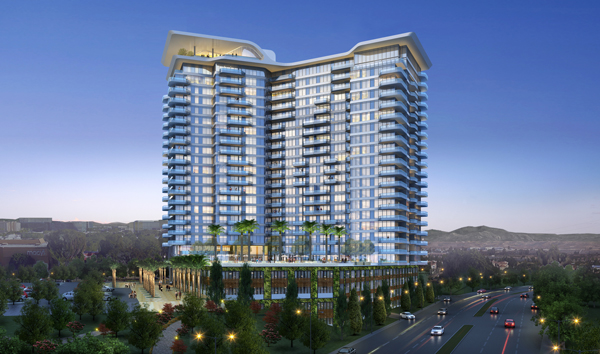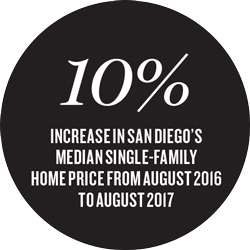Trending
Up, up and away in San Diego

As San Diego’s residential prices go up, up, up, buyers are going farther out, out, out to find a bargain.
There’s no sign of the city’s draw diminishing, with more tech companies looking at San Diego as a primary or secondary base, brokers say. Thus, housing prices continue to rise. In August, residential prices were up 10 percent across all property types over the same month last year, according to a report from the Greater San Diego Association of Realtors.
“We have very low inventory right now, and most houses, if they are priced right, are not on the market for more than 30 days,” said Theresa DeCristoforo, a Realtor with San Diego-based Ascent Real Estate.
The median price for a detached single-family home in the San Diego area in August was $610,000 — up from $563,000 at the same time last year, according to the association. Manufacturing data showing demand for housing construction materials could well result in a stronger inventory flow next year, the report noted.
The current squeeze on city inventory has led to previously overlooked parts of San Diego County attracting buyer interest, DeCristoforo said. These neighborhoods include North Park off the Interstate 805 freeway and La Mesa, 9 miles east of downtown. Rancho Bernardo, in the northern hills of the county, had the most sales in San Diego during the first half of this year, according to the San Diego Union-Tribune.
Luke Kensen, founder of boutique real estate agency House333, said that when he moved to San Diego from Los Angeles in 2006, real estate prices were considerably more affordable than they are today. Now, he says, the pricing disparities between the two cities are smaller. For example, the North Park area is only about 10 percent or so cheaper than its far better known — and equally bohemian — Los Angeles counterpart, Venice.
But renting, at least, could get easier in San Diego. In July, city regulations were loosened around the building of so-called “granny flats” — separate units on a homeowner’s property — and more of them will ease a tight rental market.
The city’s real estate experts say that a spate of upcoming new developments will also help relieve the housing shortage.
Work has begun on Westfield’s $200 million residential development in University City, which is planned to have 300 units that will come on line by 2019. Westfield is developing the site atop a former mall parking lot. The building will offer on-trend amenities like a club room and sky lounge and is expected to command premium rents that will be in line with other new developments in the city, such as the one-year-old 360 Luxury Apartments at 9065 Sydney Court, where rents are an average of $2,651 a month.
Development plans on the commercial side are heating up in San Diego as well.

In early September, Houston-based real estate investment and development company Hines announced a partnership agreement with the Levi Cushman Family Trust to redevelop the 200-acre Riverwalk golf course in Mission Valley into a mixed-use project featuring a 70-acre riverfront park. The project has a $2 billion budget and is still in the planning stages; no completion date has been set.
Hines is also planning the third tower of La Jolla Commons in San Diego’s University Town Center, which will add a further 200,000 square feet for lease in the modern and progressive office campus, which features amenities such as a putting green and bocce and basketball courts.
All of the new spaces are making room for more tech employees who will be flowing into the area.
“An expanding employment base combined with a well-educated workforce and tepid development have set the San Diego office market on firm footing,” said Joshua Ohl, a market analyst at commercial real estate research firm CoStar. Downtown San Diego especially, he said, “is setting itself up as the home for the next wave of startups.”
According to Ohl, San Diego doubled its year-over-year commercial space absorption rate in 2016. “That has helped push vacancies south of 10 percent by the middle of 2017,” he said.
Google last year leased 60,000 square feet of office space in the Sorrento Mesa area. In mid-September of this year, Amazon confirmed it had leased 107,000 square feet of office space in University City with room for more than 500 employees, the Union-Tribune reported.
But neither deal could compare with what would happen if San Diego wins its bid to be home to Amazon’s second headquarters. The company announced that it intends to invest $5 billion and hire 50,000 people in whichever city it deems the best fit. On the day that Amazon announced the project, San Diego responded. “San Diego has the geographic proximity to international markets, unparalleled quality of life and workforce talent that companies like Amazon are looking for,” said Matt Awbrey, Mayor Kevin Faulconer’s deputy chief of staff, in a statement.
But it’s not just the tech giants in the San Diego spotlight. A seven-story building that had not changed hands in 63 years was sold in an off-market transaction in September to Ocean West Capital Partners in partnership with DivcoWest, both real estate investors and developers. Global real estate investment and services firm Kennedy Wilson negotiated the two-part sale of the ground lease and underlying fee interest in the land at 1420 Kettner Boulevard, in the Little Italy section of San Diego. The building, which sits on 2.6 acres and comprises 123,000 square feet, will undergo a multimillion-dollar renovation and, according to a statement from Ryan Tucker, director at Ocean West, will be transformed into a “progressive office campus with a wealth of amenities and outdoor space for tenants seeking an active and unique work environment.”
Certainly, Little Italy — a downtown neighborhood that was once an Italian fishing outpost — is having a moment, said Fred Cordova, executive vice president of Kennedy Wilson Properties Group.
The area, which takes up 48 blocks, “is going through an incredible renaissance right now,” said Cordova. “It’s going to become what South of Market is to San Francisco,” he said, referencing the area popularly known as SoMa, which houses trendy bars and eateries, boutique hotels and art galleries. “The only difference is it that there will be a more dramatic [transformation] given the high-rise multifamily developments and restaurants in its immediate vicinity,” he added.
House333’s Luke Kensen adopts a more romantic view of the city.
“With all the development, and the high-rises coming,” he said. “San Diego is going to have that sexy skyline.”




